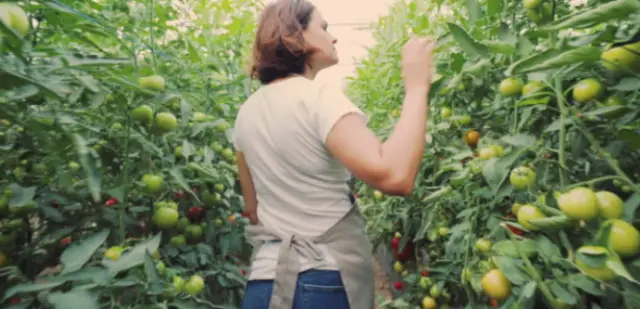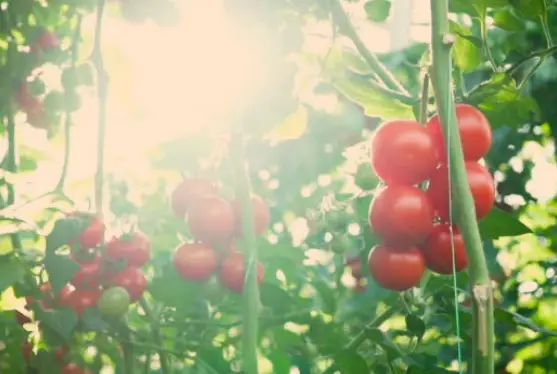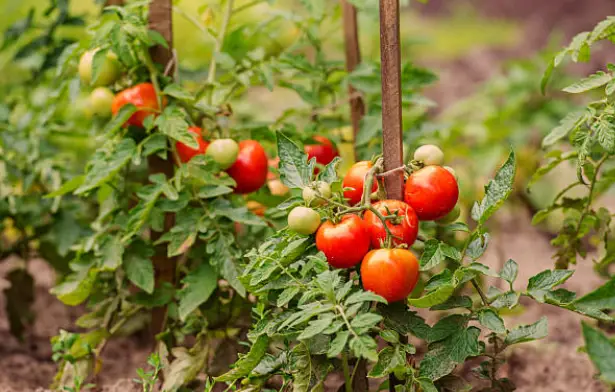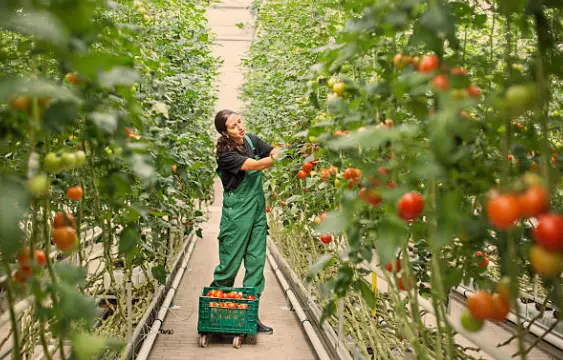Having a consistent supply of fresh, homegrown tomatoes is the dream for anyone who loves tomatoes as much as I do. While growing tomatoes outdoors is often simple in warm climes, growers in lower climates frequently face challenges from limited growing seasons and erratic weather. Here’s where owning a greenhouse can really make all the difference! You may increase the length of your tomato growing season and yield a bumper crop of tasty, juicy tomatoes by creating a controlled environment.
Everything you need to know to grow tomatoes effectively in a greenhouse will be covered in this tutorial, from selecting the best kinds to providing regular care and upkeep. This page has all the information you need, whether you are new to greenhouse growing or want to increase your tomato production. Now let us get started!
Greenhouse Advantages for Tomatoes
Let us examine the advantages of growing tomatoes in a greenhouse before getting into the details:

1. Extended Growing Season
The ability to start tomato plants earlier in the spring and continue them to grow later into the fall is by far the greatest benefit of having a greenhouse. When compared to outdoor gardening, this results in a significantly longer harvesting season.
2. Protection from Pests and Disease
Deer, rabbits, and even some insects are among the frequent garden pests that greenhouses help to keep at bay. By enabling the use of sterile potting mixes, they also aid in the prevention of soil-borne illnesses.
3. Controlled Climate
In a greenhouse, you have far more control over the climate, including ventilation, humidity, and temperature. This enables you to give your tomato plants the best possible growing environment.
4. Rain Protection
While tomatoes need consistent moisture, too much rain can lead to cracked fruits, disease, and fungal issues. A greenhouse shields your plants from excessive rainfall.
Choosing Greenhouse Tomato Varieties
It can be difficult to decide one of the hundreds of tomato types to produce. Here are some pointers:

– Determinate or Indeterminate?
Determinate tomatoes are bush varieties that stop growing when fruit sets. Indeterminate varieties are vining plants that continue producing until killed by frost. For a greenhouse, indeterminate types are usually preferable for their extended harvests.
– Size Considerations
Pay attention to the mature plant size. Go for dwarf or compact varieties if you have limited greenhouse space. Larger slicing tomatoes need more room than cherries or plums.
– Best Greenhouse Performers
Some top greenhouse tomato choices are Sun Gold and Sweet Million (cherry), Campari (cocktail), Big Beef and Trust (slicing), and heirloom varieties like Brandywine.
– Resistance Package
Look for tomato varieties with good resistance to common greenhouse issues like blight, fusarium wilt, verticillium wilt, and viruses.
Setting Up Your Greenhouse
There are a few key elements to take into account while setting up the perfect greenhouse for producing tomatoes:

GreenhouseSize and Layout
The size greenhouse you’ll need depends on how many tomato plants you want to grow. At minimum, plan for about 2-3 square feet per plant. Larger indeterminate varieties need 4+ square feet each. Good air flow and accessibility are also essential, so avoid cramming plants too close together.
Lights
Most greenhouses rely on natural light, but you may need supplemental lighting to get vigorous growth in spring and fall when daylight is less intense. Choose high-output LED or HID grow lights.
Heating and Cooling
An electric heater, gas furnace, or hotbed system provides essential warmth for early spring and late fall tomatoes. Proper venting, exhaust fans, and evaporative cooling are a must for hot summers.
Irrigation
Tomatoes need consistently moist (but not saturated) soil. Drip irrigation or a simple sprinkler system allows you to control moisture levels perfectly.
Environmental Controls
Automated systems allow you to monitor and adjust temperature, humidity, venting, lighting, and irrigation at the push of a button.
Planting and Care
Once your greenhouse is set up properly, you’re ready to start growing some tomatoes! Here are my top tips:
Soil
Opt for a premium potting mix made for vegetables. These sterile soilless mixes provide excellent drainage and aeration for optimum root growth. Tomatoes also enjoy an ample supply of nutrients and calcium.
Containers
Grow bags, large nursery pots, or raised beds are all great container choices. Avoid anything too small. 5-gallon buckets or grow bags are the minimum recommended size.
Planting Time
Set out tomato transplants 2-4 weeks after your last expected frost date. Pay close attention to nighttime temperatures – tomatoes can’t handle cold!
Plant Care
Water tomatoes slowly and deeply, about 1-2 inches per week. Use fertilizer according to label instructions, as greenhouse tomatoes are heavy feeders. Removing suckers (side shoots) on indeterminate plants focuses energy on fruit production.
Staking and Trellising
Indeterminate varieties require staking or trellising to keep plants upright and fruits off the ground. Invest in sturdy tomato cages, stakes, or a strong trellis system.
Pollination
Hand pollination by vibrating flowers or using an electric pollinator ensures good fruit set in low-wind greenhouse conditions.
Pruning and Maintenance
Regularly prune off any dead, diseased, or unwanted growth to increase airflow and reduce pest/disease pressure. Additionally, remove branches and foliage shading ripening tomatoes.
Harvest
The truly exciting part! Tomatoes are typically ready to pick 60-100 days after transplanting, depending on variety. Harvest frequently once they begin ripening for maximum production.
Common Greenhouse Tomato Problems
Like any crop, growing greenhouse tomatoes does come with a few potential issues. Being aware of these will help you catch problems early:
Blossom End Rot
This condition causes water-soaked spots on bottomsof fruits that turn leathery brown or black. It’s caused by calcium deficiency and irregular watering.
Leaf Diseases
Spots, yellowing, or withering of foliage can be signs of fungal diseases like early blight, late blight, septoria leaf spot, or powdery mildew. Good air circulation helps prevent these.
Blossom Drop
When flowers fall off without setting fruit, it’s likely due to temperature extremes, low humidity, or insufficient pollination.
Pest Problems
Typical greenhouse pests include spider mites, aphids, thrips, and whiteflies. Use insecticidal soaps, neem oil, or beneficials for control.
Cracking
Tomatoes that develop cracks or splits are reacting to inconsistent moisture levels. Maintain even watering to prevent this.
There’s No Better Way to Tomato
I could write a book on the benefits of growing luscious, juicy tomatoes in a greenhouse. For any vegetable gardener, it is a very rewarding endeavor that can lengthen your harvest season and create the ideal environment for abundant yields.
Gaining expertise in greenhouse tomato cultivation will set you up for success in producing the freshest, tastiest tomatoes possible, regardless of the size of your greenhouse a hobby greenhouse or a major commercial enterprise. You are well on your way to becoming an expert greenhouse tomato grower with the advice and methods provided here! I wish you well as you pursue your greenhouse growing goals.


